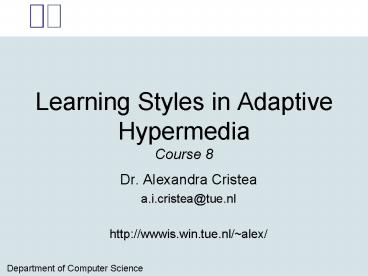Learning Styles in Adaptive Hypermedia Course 8 - PowerPoint PPT Presentation
1 / 30
Title:
Learning Styles in Adaptive Hypermedia Course 8
Description:
Department of Computer Science. Learning styles & AH ... model; the application of a Bayesian network is planned to predict and recommend ... – PowerPoint PPT presentation
Number of Views:101
Avg rating:3.0/5.0
Title: Learning Styles in Adaptive Hypermedia Course 8
1
Learning Styles in Adaptive Hypermedia Course 8
- Dr. Alexandra Cristea
- a.i.cristea_at_tue.nl
- http//wwwis.win.tue.nl/alex/
2
Adaptive System course parts
- Adaptive Systems, Generalities
- User Modeling
- Data representation for AS
- Data manipulations for AS
- Adaptive Hypermedia as AS
- Authoring for Adaptive Hypermedia
- LAOS for AH
- LAG for AH
- MOT for AH
- Learning Styles in AH
- Other types of Adaptive Systems
- Conclusions
3
Learning styles AH
- ARTHUR, iWeaver, MANIC, CS388 sensory
preferences - AEC-ES field-dependent (FD) independent (FI)
- LSAS, CS388 global-sequential (Felder-Silverman)
- Tangow sensing-intuitive dimension
(Felder-Silverman) - INSPIRE Honey and Mumford model
- etc..
4
Learning styles AH
- ARTHUR, iWeaver, MANIC, CS388 sensory
preferences - AEC-ES field-dependent (FD) independent (FI)
- LSAS, CS388 global-sequential (Felder-Silverman)
- Tangow sensing-intuitive dimension
(Felder-Silverman) - INSPIRE Honey and Mumford model
- etc..
5
Sensory preferences treatment
- Adaptive presentations can switch between the
following styles - textual (hyper-text)
- visual (image, diagrams, graphs, video,
slideshows) - auditory (sounds, streaming audio)
- kinaesthetic views (animations, simulations,
puzzles)
6
Dunn Dunn model
7
Sensory preferences in AH
- CS388 (1996)
- Felder-Silverman learning styles model
global-sequential, visual-verbal,
sensing-intuitive, inductive-deductive styles - ARTHUR (1999)
- visual-interactive, auditory-lecture and text
styles - MANIC (2000)
- uses a Naïve Bayes Classifier to reason about the
learners preferences in terms of explanations,
examples and graphics - iWeaver (2002)
- Dunn Dunn model the application of a Bayesian
network is planned to predict and recommend media
representations to the learner.
8
(No Transcript)
9
(No Transcript)
10
Auditory Interface, iWeaver
11
Visual Interface, iWeaver
12
Learning styles AH
- ARTHUR, iWeaver, MANIC, CS388 sensory
preferences - AEC-ES field-dependent (FD) independent (FI)
- LSAS, CS388 global-sequential (Felder-Silverman)
- Tangow sensing-intuitive dimension
(Felder-Silverman) - INSPIRE Honey and Mumford model
- etc..
13
FD vs. FI treatment
- FD learners prefer
- structures,
- social content,
- material relevant to own experience.
- AH systems respond by
- providing navigational support tools (CM, path
indicator, advanced organizer) adaptive
navigation support
14
FD vs. FI treatment
- FI learners
- perceive analytically,
- make concept distinctions,
- prefer impersonal orientation.
- AH systems respond with
- learner control arbitrary succession of course
material. - Sometimes explicit switching between FI FD.
15
- AES-CS (2000)
- Adaptive Educational System base on cognitive
styles - http//www.vrc.gr/browse_en/ShowProduct.aspx?id44
16
Learning styles AH
- ARTHUR, iWeaver, MANIC, CS388 sensory
preferences - AEC-ES field-dependent (FD) independent (FI)
- LSAS, CS388 global-sequential (Felder-Silverman)
- Tangow sensing-intuitive dimension
(Felder-Silverman) - INSPIRE Honey and Mumford model
- etc..
17
- CS388 (1996)
- LSAS
- Global or sequential learning style
- http//www.archives.ecs.soton.ac.uk/users/nb99r/in
tro_short/frame.htm
18
(No Transcript)
19
Felder-Silverman
- 44 questions at
- http//www.engr.ncsu.edu/learningstyles/ilsweb.htm
l - Index of Learning Styles (1991)
- Richard M. Felder, a chemical engineering
professor at North Carolina State University, - Barbara A. Soloman, then the coordinator of
advising for the N.C. State First-Year College. - The four learning style dimensions of the
instrument were adapted from a model developed in
1987 by Dr. Felder and Linda K. Silverman, an
educational psychologist then at the University
of Denver.
20
(No Transcript)
21
(No Transcript)
22
Learning styles AH
- ARTHUR, iWeaver, MANIC, CS388 sensory
preferences - AEC-ES field-dependent (FD) independent (FI)
- LSAS, CS388 global-sequential (Felder-Silverman)
- Tangow sensing-intuitive dimension
(Felder-Silverman) - INSPIRE Honey and Mumford model
- etc..
23
Learning styles AH
- ARTHUR, iWeaver, MANIC, CS388 sensory
preferences - AEC-ES field-dependent (FD) independent (FI)
- LSAS, CS388 global-sequential (Felder-Silverman)
- Tangow sensing-intuitive dimension
(Felder-Silverman) - INSPIRE Honey and Mumford model
- etc..
24
Learning styles AH
- ARTHUR, iWeaver, MANIC, CS388 sensory
preferences - AEC-ES field-dependent (FD) independent (FI)
- LSAS, CS388 global-sequential (Felder-Silverman)
- Tangow sensing-intuitive dimension
(Felder-Silverman) - INSPIRE Honey and Mumford model
- etc..
25
Selected ModelHoney and Mumford model
Activist I like to have a go and see what happens
Pragmatists I like tried and tested techniques
that are relevant to my problems
Theorist I like to tidy up and reach some
conclusions
Reflector I like to gather information and mull
things over
26
Presentation of MOT user guide to verbalizer
27
(No Transcript)
28
Presentation of MOT user guide to imager
29
(No Transcript)
30
Authoring strategies with MOTadapt (old)
- http//wwwis.win.tue.nl/acristea/HTML/Minerva/pap
ers/ACristeaWWWEducationTrack-AdaptiveCourse-final
-2give.pdf - This is interesting conceptually (to give ideas),
but for the project you need to use the new,
extended syntax































